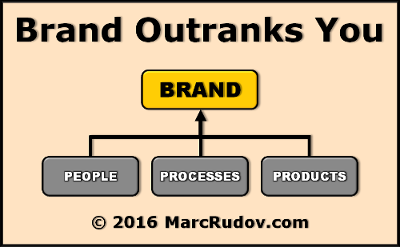 Every company, no matter its size or industry, feels compelled to construct a mission statement — but rarely obligated to create a brand.
Every company, no matter its size or industry, feels compelled to construct a mission statement — but rarely obligated to create a brand.
Some also craft a “vision” statement. More time-wasting nonsense.
Many believe that the mission statement shapes company direction and rallies the troops. It does not.
Typical creation process?
Form a buzzword-happy, politically correct committee. Google boilerplate examples. Attend seminars. Read white papers. Hire a consultant. Copy and modify competitors’ nebulous blatherings.
RESULT: Useless, generic, internally oriented, forgettable, uninspiring gobbledygook.
If you want to learn whether employees have any clue about their company’s purpose and direction — THAT is what a brand defines — and whether they’re on the same page and marching in unison, make a purchase. Then, call customer service when the process goes awry (read about my personal customer-experience nightmare in “Best Buy? You Cannot Be Sirius!”).
What you’ll discover, after encountering a problem, is that the vendor’s left and right hands have yet to meet — certifying a lack of corporatewide buy-in of purpose and direction. Yet, this supplier has a mission statement, and maybe a vision statement.
Functional and Operational Jargon
Let’s examine the mission statements of the top-two companies on the 2019 Fortune 500 list: Walmart and ExxonMobil, respectively.
Walmart’s mission statement: “to save people money so they can live better.” Walmart’s brand, expressed in its tagline: Save Money. Live Better.
A rare example of the mission statement and brand being identical. And, it’s customer-focused, concise, memorable, meaningful, and repeatable. It reflects what Walmart’s customers desire, in their language.
A more-common example is ExxonMobil’s mission statement: “ExxonMobil is committed to being the world’s premier petroleum and chemical manufacturing company. To that end, we must continuously achieve superior financial and operating results while adhering to high ethical standards.”
Functional and operational jargon. Nothing about customers. I guarantee that no ExxonMobil employee can remember this committee-derived, meaningless, generic pablum and won’t even try.
Unifying Force
The only way to rally your employees to march in the same direction, to work as a team for a single purpose, is to create and articulate a brand, as Walmart did. A brand is a concise, memorable, repeatable, customer-validated value proposition, expressed in customer language.
WARNING: If you ask your employees to memorize and internalize multiple statements (brand, mission, vision), they’ll ignore all of them and work according to their own agendas. Ring a bell?
As I’ve written ad nauseam, the brand, if it’s effective, drives every activity at your company. It dictates the people you hire, the processes you implement, and the products you build.
A strong, effective brand unifies the enterprise. It puts all employees, in all departments, on the same page. It distills all corporate communications into a single message, or pitch, for all constituents — ending the usual internal and external confusion and conflicts.
Parting Advice to CEOs
Ditch your mission statement — and your vision statement, if you have one. Each is a useless corporate cliché that nobody will recite, remember, or adopt.
Multiple messages disorient your employees, confuse investors and reporters, and muddle your true mission: to magnetize your customers.
What matters is your brand, the emotional connection customers have to your company.
If your brand is weak or nonexistent, fix it — yesterday.
© 2019 Marc H. Rudov. All Rights Reserved.
About the Author

Marc Rudov is a branding advisor to CEOs,
producer of MarcRudovTV, and author of four books



